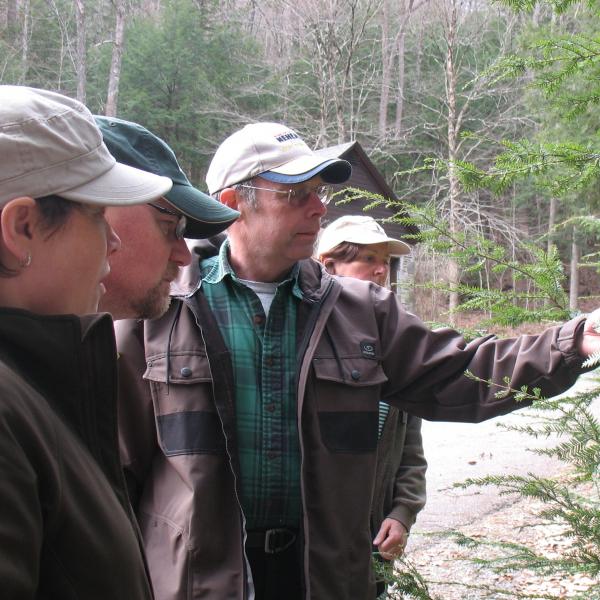
Clarion, PA, July 28-30, 2015
In late July staff from Vermont went to a meeting in Clarion Pennsylvania for the latest on hemlock woolly adelgid (HWA) management. Other participants represented 18 states from Maine to Georgia, as well as the USFS, National Park Service, The Nature Conservancy, Virginia Tech, University of Rhode Island and University of Tennessee. The meeting was meant to be a “nuts and bolts” meeting to allow program managers the opportunity to share ideas and information about implementing various parts of the National HWA Strategic Plan and Initiative.
In 2003, the USFS and USDA-APHIS, in cooperation with the National Association of State Foresters and the National Plant Board, formed the HWA Initiative by pulling together workers and researchers from federal and state agencies, universities and industry to coordinate and accelerate efforts to reduce the spread and impact of HWA.
Vermont, relatively speaking, is still the new kid on the block. Although stand decline has been observed, we are not yet finding hemlock mortality. Many of the representatives reported that mortality is common in their jurisdictions. Elongate hemlock scale, only recently found in Vermont, is becoming common elsewhere and in some places regarded as the more severe threat. For more information http://na.fs.fed.us/spfo/pubs/pest_al/ehscale/ehscale.htm . Sirococcus tip blight is another threat to hemlock trees that has been observed in Vermont and is reported as a serious threat in some areas - http://na.fs.fed.us/pubs/palerts/tip_blight/tip_blight_lo_res.pdf . When these pests are found together they accelerate tree decline and mortality.
Most participants reported a high HWA mortality rate from this winter’s cold temperature, however there was general agreement that the pest seems be adapting to cold temperatures. It was also noted that the minimum low temperature may not be as critical as the duration and timing of the cold. There is also summer mortality – aestivating adelgids, sometimes as many as 60%, have been found to die before they developed their wool in the fall. Heat and desiccation are thought to be the cause.
Early detection is important, but inspecting upper portions of hemlocks has always been difficult. One participant shared that they sample upper branches by throwing squash balls wrapped in Velcro into hemlock crowns using a device made for throwing balls for dogs to fetch. HWA ovisacs stick to the ball. They have not worked out how to quantify the level of infestation with this technique, but are able to do presence/absence surveys. Initially they had problems with balls bouncing and rolling downhill, but solved that by puncturing the ball and placing some wood pellets inside to deaden it.
Education was acknowledged as an important component in managing hemlock woolly adelgid. Most states mentioned some sort of outreach. Vermont is one of just a few states that use volunteers extensively. Vermont volunteers also do a large proportion of the survey work which is critical to inform management decisions.
A great deal of time was spent discussing chemical treatment. There was consensus that treatment protects hemlocks, as long as they are generally healthy. Many state and federal land management agencies have their own crews to conduct chemical treatments. Many are significant, long-term efforts, for example the Great Smokey Mountains National Park has treated >200,000 trees. Some also have cooperative programs. The treatment cycle is generally 5-7 years, but efficacy can be for up to 10 years if enough trees are treated within the area to suppress the HWA population locally.
There was an acknowledgement that some of the popular insecticides are controversial, but not much mention of the type of resistance we have faced in Vermont.
There was a wide variety of opinions and practice in the area of chemical control. Costs were highly variable, ranging from 10¢ to $8.75 per diameter inch.
Biocontrol is seen as the critical component of a long range approach to HWA. A number of predatory insects are approved, and a few have been widely released. Climate determines which is appropriate for a particular location. There has been significant natural expansion of the most widely released predator, Laricobius nigrinus. For example, the beetle was released at 10 sites in New Jersey, and it has been recovered, so far, at 59 sites. Laricobius has been released in three sites in Vermont.
Some areas where introduced predatory beetles are well established are able to supply beetles for other locations. There is a movement to establish “field insectaries” for this purpose. Some participants claimed that biocontrols are working and that treated areas look better than areas with no beetles, but so far, there seems to be little empirical data to show that trees are being saved. Recent results may have been impacted by the cold winters of the last two years. It is believed to be too early to tell yet; data are still being gathered.
A particular focus of resistance work has been New Jersey’s “bulletproof” stand. Elevated turpenoid levels in these trees may contribute to their apparent resistance. Clones are ready for outplanting. An on-line form for submitting healthy hemlocks is available through the Alliance for Saving Threatened Forests.
There was a discussion about the need for guidelines for restoration. There are differing opinions about planting other conifers in effected areas to replace hemlock. Some suggest that hemlock could be planted and protected using a concurrent treatment of slow-release insecticide, such as Coretect.
We attended a field trip to a study area that was thinned to see if manipulating stands to put more crown on the hemlocks would allow the hemlocks to fare better when HWA arrives. The data are still being gathered. VT FPR, in conjunction with forest health experts in New Hampshire and Maine have produced a document that should be released soon about managing hemlock in northern New England that is threatened by HWA and EHS.
By Jim Esden, Forester, VT Department of Forests, Parks and Recreation